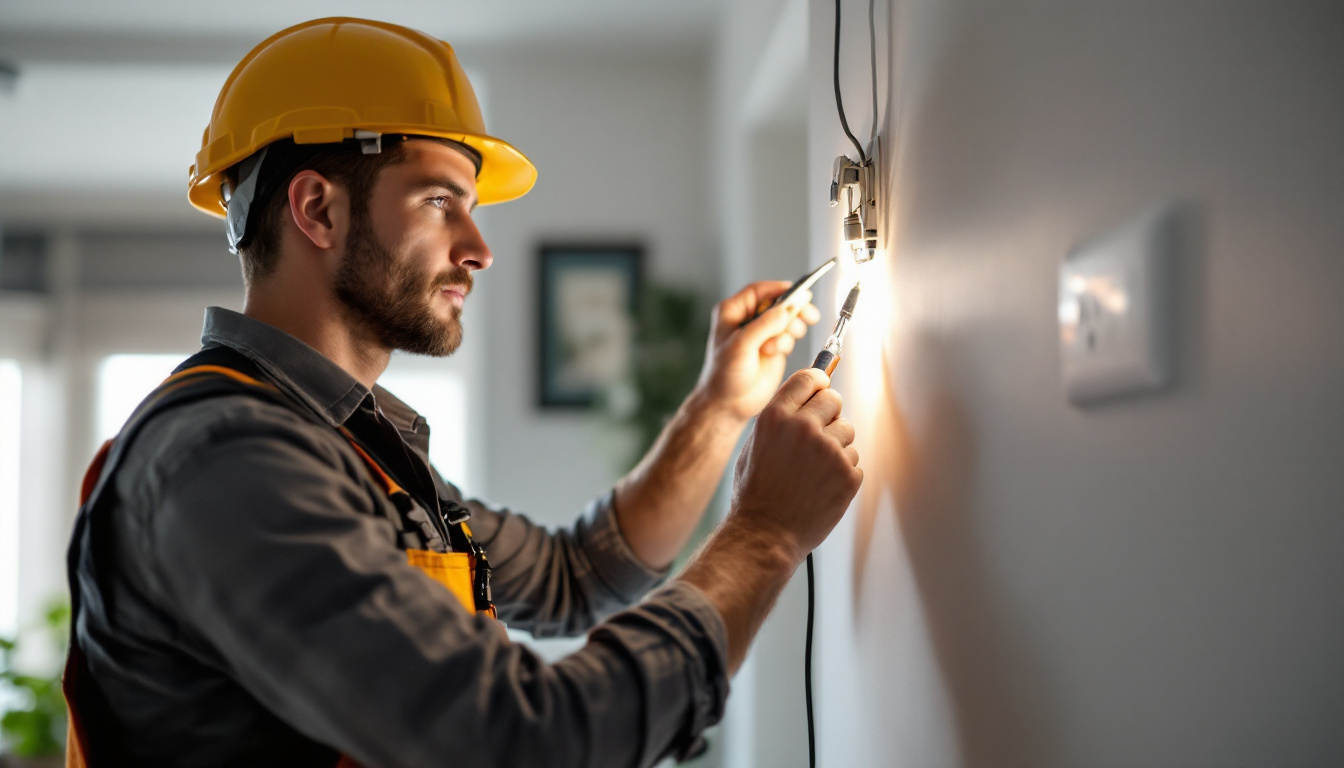
In the world of electrical installations, the electric wall socket stands as a fundamental component. For lighting contractors, understanding the nuances of wall socket installation and maintenance is crucial for delivering safe, efficient, and aesthetically pleasing results. This article delves into the top strategies that lighting contractors can employ to optimize their work with electric wall sockets, ensuring both functionality and client satisfaction.
Before diving into advanced strategies, it is essential to have a solid understanding of the basic components and functions of electric wall sockets. These devices are designed to provide a safe and reliable point of access for electrical devices. They come in various types, including standard outlets, GFCI (Ground Fault Circuit Interrupter) outlets, and USB-integrated sockets, each serving a unique purpose.
Lighting contractors should be familiar with the different types of wall sockets available on the market. Standard outlets are the most common, used for general electrical needs. GFCI outlets are particularly important in areas prone to moisture, such as kitchens and bathrooms, as they help prevent electrical shocks. USB-integrated sockets are gaining popularity, offering convenience for charging devices without the need for an additional adapter. Additionally, there are smart sockets that can be controlled remotely via smartphone apps, allowing users to manage their energy consumption more efficiently and even set schedules for when appliances should be powered on or off.
Each wall socket consists of several key components, including the faceplate, receptacle, and internal wiring. Understanding how these components work together is vital for successful installation and troubleshooting. The faceplate provides a protective covering, while the receptacle houses the electrical connections. Proper wiring is essential to ensure safety and functionality. Furthermore, the internal components often include a spring-loaded mechanism that ensures a secure connection with the plug, reducing the risk of loose connections that can lead to overheating or electrical fires. It’s also worth noting that many modern wall sockets are designed with built-in surge protection, which can safeguard sensitive electronics from voltage spikes caused by lightning strikes or power surges.
Effective planning is a cornerstone of successful wall socket installation. Lighting contractors must consider various factors, including the layout of the space, the specific needs of the client, and compliance with local electrical codes. A well-thought-out plan not only ensures safety and functionality but also enhances the overall user experience by anticipating future needs and potential upgrades.
Every client has unique requirements when it comes to electrical installations. Conducting a thorough assessment of their needs is crucial. This may involve discussing their lifestyle, the types of devices they use, and their preferences for socket placement. By understanding these factors, contractors can recommend the most suitable types of sockets and their locations. For example, a tech-savvy client might require multiple USB ports integrated into their outlets, while a family with young children may prioritize safety features such as tamper-resistant sockets. Engaging in open dialogue helps to build trust and ensures that the installation meets the client’s expectations.
In addition to functional requirements, aesthetic considerations play a significant role in socket placement. The design of the space should guide the positioning of outlets. For instance, in a modern kitchen, strategically placed sockets can enhance both usability and visual appeal. Contractors should collaborate with clients to ensure that the final design aligns with their vision while maintaining practicality. Moreover, the choice of socket finishes and colors can complement the overall décor, whether it’s a sleek, minimalist look or a more traditional style. The integration of smart home technology also offers exciting possibilities, allowing for seamless control of lighting and appliances, which can be both a functional and stylish addition to any space.
Once planning is complete, the next step involves the actual installation of the wall sockets. Employing the right techniques is essential for ensuring safety and longevity. proper installation not only enhances the functionality of electrical systems but also contributes to the overall aesthetic appeal of a space. Whether it’s a residential or commercial setting, attention to detail during the installation process can make a significant difference in the performance of electrical outlets.
Wiring is a critical aspect of socket installation. Lighting contractors should adhere to best practices, such as using the correct gauge of wire and ensuring secure connections. It is also vital to follow the manufacturer’s instructions for each socket type. This attention to detail can prevent future issues and ensure that the installation meets safety standards. Additionally, contractors should consider the environment in which the sockets will be installed; for instance, moisture-prone areas may require weather-resistant materials and special wiring techniques to mitigate risks. Understanding local electrical codes and regulations is equally important, as these guidelines are designed to protect both the installer and the end-user from potential hazards.
After installation, testing the sockets for functionality and safety is imperative. Using a multimeter, contractors can check for proper voltage and continuity. Additionally, GFCI outlets should be tested to ensure they trip correctly when a fault is detected. This step not only guarantees safety but also builds trust with clients, demonstrating a commitment to quality work. Beyond basic testing, it is advisable to conduct a thorough inspection of the entire electrical system, looking for signs of wear, loose connections, or outdated components that could compromise safety. Regular maintenance checks and educating clients on how to use their electrical systems safely can further enhance the reliability of the installation, ensuring that the sockets serve their purpose effectively for many years to come.
Even the best installations may require maintenance over time. Understanding how to identify and address common issues can save contractors time and enhance client satisfaction.
Lighting contractors should be aware of common problems that can arise with wall sockets, such as loose connections, tripped circuit breakers, or malfunctioning GFCI outlets. Recognizing these issues early can prevent more significant problems down the line. Regular inspections can help identify wear and tear, ensuring that sockets remain in good working condition.
When issues arise, having a systematic approach to troubleshooting is essential. Contractors should start by checking the power supply and ensuring that circuit breakers are functioning correctly. If a socket is not working, examining the wiring for any visible damage or loose connections is the next step. For GFCI outlets, resetting the device may resolve the issue. If problems persist, consulting the manufacturer’s guidelines or seeking professional assistance may be necessary.
The quality of wall sockets can significantly impact the overall success of an installation. Lighting contractors must be discerning when selecting products for their projects.
While cost is always a consideration, prioritizing quality is essential for long-term satisfaction. High-quality wall sockets may come at a higher initial price, but they often provide better performance and durability. Contractors should educate clients on the benefits of investing in reliable products, emphasizing safety and longevity.
Researching brands and reading reviews can help contractors make informed decisions. Established brands often have a track record of reliability and customer satisfaction. Engaging with online forums or trade groups can also provide valuable insights into which products perform best in real-world applications.
The electrical industry is constantly evolving, with new technologies and trends emerging regularly. Lighting contractors must stay informed to remain competitive and provide the best service to their clients.
Smart home technology is one of the most significant trends impacting the electrical industry. Many homeowners are now seeking smart sockets that can be controlled remotely or integrated with home automation systems. Understanding these technologies and how to install them can give contractors a competitive edge.
Investing in ongoing education and training is crucial for lighting contractors. Workshops, online courses, and trade shows offer opportunities to learn about new products, installation techniques, and industry standards. Staying updated not only enhances skills but also fosters credibility with clients.
Effective communication with clients is vital throughout the installation process. Educating clients about their options and the importance of proper maintenance can lead to better outcomes and increased satisfaction.
Before starting any project, it is important to set clear expectations with clients. Discussing timelines, potential challenges, and the scope of work can help prevent misunderstandings. Providing a detailed project plan can also reassure clients that their needs are being prioritized.
After the installation is complete, offering guidance on how to use and maintain the sockets can enhance client satisfaction. Providing written instructions or a quick demonstration can empower clients to feel confident in their new installations. This follow-up can also open the door for future projects, as satisfied clients are more likely to recommend services to others.
In the realm of lighting contracting, mastering the strategies surrounding electric wall sockets can significantly enhance the quality of work and client satisfaction. From understanding the basics and planning installations to choosing the right products and maintaining effective communication, each aspect plays a crucial role in the overall success of a project. By implementing these top strategies, lighting contractors can ensure that their installations are not only functional but also safe and aesthetically pleasing, ultimately leading to a thriving business.
Ready to elevate your lighting projects with the highest quality electric wall sockets and lighting products? Look no further than LumenWholesale. Our commitment to empowering contractors like you with spec-grade lighting solutions at unbeatable wholesale prices sets us apart. With LumenWholesale, you can say goodbye to inflated markups and hello to a vast selection of reliable, high-performance products that meet the strictest industry standards. Plus, with the convenience of free shipping on bulk orders, you can stock up on premium lighting essentials at the best value without any hidden fees. Make your next project a shining example of quality and affordability. Wholesale Lighting at the Best Value is just a click away.

Discover the crucial role outdoor step light fixtures play for lighting contractors in enhancing safety, aesthetics, and energy efficiency.

Discover how LED lights for canned light fixtures can significantly cut costs for lighting contractors.

Discover the insider secrets of lighting contractors as they master the art of AV poles and lighting.

Explore the key challenges lighting contractors face in the evolving industry landscape.